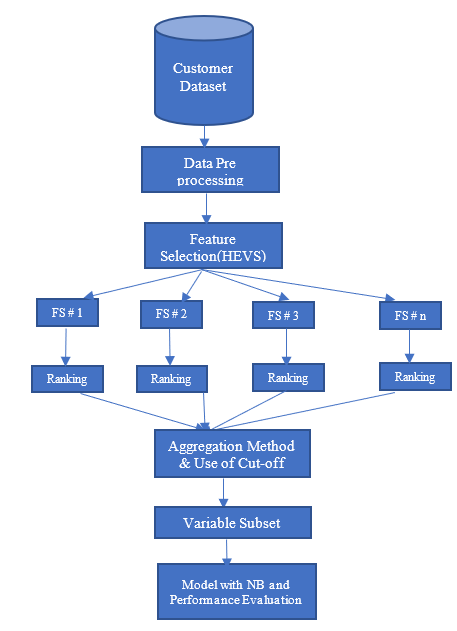Heterogeneous Ensemble Variable Selection To Improve Customer Prediction Using Naive Bayes Model
Main Article Content
Abstract
The analysis of customer patterns and behaviours is essential for all businesses, as the customer is the sole source of revenue. Understanding customer patterns and behavior enables businesses to enhance their business processes and customer happiness. The availability of voluminous client datasets within organizations facilitates efficient customer analysis. Yet, the inclusion of interrelated, irrelevant, as well as missing factors leads to a poor forecast of the dataset. Feature selection techniques are investigated in order to handle the problem. Objective of feature selection is to pick the pertinent variables from a complete set of associated, irrelevant, and missing variables. In general, FS is classified into 3 types: filter, wrapper, & hybrid method. The filter method is a quick one, but the variables used are ineffective. Similarly, a wrapper method is effective yet computationally inefficient. In this study, an ensemble feature selection strategy is presented and tested to circumvent the issue with these feature selections. There are two techniques to ensemble FS: one is homogenous and the other is heterogeneous. This study employs a heterogeneous ensemble feature selection method. In the suggested method, the learning dataset is applied to five distinct filter FS approaches, and the ranked attributes that result are aggregated using two distinct methods: the mean method and the min method. Relevant variables are chosen to further build the final sorted qualities using the cut off value as a guide. As the HEVS technique's filter approach simply ranks the variables, it is necessary to select the variable subset cut off value. The experimental technique is conducted from two distinct vantage points: Heterogeneous ensemble variable selection with Naive Bayes and Naive Bayes without variable selection. In the end, the outcomes that were obtained via the use of the two different approaches are compared using different factors. The experimental results demonstrate that the suggested HEVS method outperforms the usual Naive Bayes model. As relevant variables are included when modeling using NB, the computational complexity of this proposed methodology is also minimized.
Article Details
References
R.Siva Subramanian & Dr.D.Prabha, 'A survey on customer relationship management', 4th International Conference on Advanced Computing and Communication Systems (ICACCS), Coimbatore, Electronic ISBN: 978-1-5090-4559-4 pp. 1-5, 2017
Dr.S.Balakrishnan & Dr.M.Karpagam, ,'Performance Evaluation of Naive Bayes Classifier with and without Filter Based Feature Selection', International Journal of Innovative Technology and Exploring Engineering (IJITEE) ISSN: 2278-3075, Vol-8 Issue-10, 2019, pp.2154-2158.
Chih-Wen Chen, Yi-Hong Tsai, Fang-Rong Chang,Wei-chao Lin, ”Ensemble feature selection in medical datasets: Combining filter, wrapper, and embedded feature selection results”, Expert Systems, Vol.37, Issue 5, 2020, e12553.
Kang Leng Chiew, Choon Lin Tan, KokSheik Wong, Kelvin S.C.Yong, Wei King Tiong,” A New hybrid ensemble feature selection framework for machine learning-based phishing detection system”, Information Sciences, Vol.484, 2019, pp.153-166.
Barbara Pes,” Ensemble feature selection for high-dimensional data: a stability analysis across multiple domains”, Neural Computing and Applications, Vol.32, 2020,pp.5951-5973.
Diwakar Tripathi, Damodar Reddy Edla, Ramalingaswamy Cheruku, venkatanareshbabu Kuppilli,” A novel hybrid credit scoring model based on ensemble feature selection and multiplayer ensemble classification”, computational Intelligence, Vol.35, issue.2,2019, pp.371-394.
Supoj Hengpraprohm, Thaksin Jungjit,” Ensemble Feature Selection for Breast Cancer Classification using Microarray Data”, Intelligencia Artificial, vol.23, 2020, No.65.
Veronica Bolon-Canedo and Amparo Alonso-Betanzos,” Ensembles for feature selection: A review and future trends”, Information fusion, Vol.52, 2019,pp.1-12.
Siva Subramanian.R and Prabha.D,” Ensemble Variable Selection for Naïve Bayes to Improve Customer Behaviour Analysis”, Computer Systems Science & Engineering, Vol.41, No.1, 2022, pp.339-355.
Yuyang Zhou, Guang Cheng, Shanqing Jiang, Mian Dai, “ Building an efficient intrusion detection system based on feature selection and ensemble classifier”, Computer Networks,Vol.174, 2020, 107247.
Doaa N.Mhawi, Ammar Aldallal, Soukeana Hassan, Advanced Feature-selection-Based Hybrid Ensemble Learning Algorithms for Networks Intrusion Detection Systems”, Symmetry, vol.14, 2022, No.7, 1461.
Jingfang Liu and Mengshi Shi,” A Hybrid Feature Selection and Ensemble Approach to Identify Depressed Users in Online Social Media”, Frontiers in Psychology, 2021,Vol.12.
Dr.J.Aswini, Mrs. B.Maheswari & Mrs.M.Anita,. Alleviating NB conditional independence using Multi-stage variable selection (MSVS): Banking customer dataset application. Journal of Physics: Conference Series. 1767. 012002, 2021.
R.Siva Subramanian, R & Dr.D.Prabha, “Ensemble variable selection for Naive Bayes to improve customer behaviour analysis", Computer Systems Science & Engineering, Tech Science Press, Vol.41, No.1, 2022,pp.339-355.
S. N. Bushra, Dr.J.Aswini, G.Nirmala, B.Maheswari,2022, Customer Analysis using Machine Learning with Feature Selection Approaches: A Comparative Study", 2022 International Conference on Augmented Intelligence and Sustainable Systems (ICAISS), Trichy, India, pp. 196-202,2022

